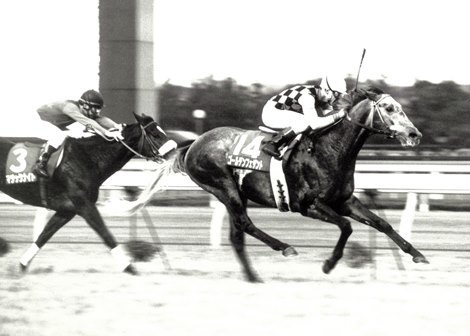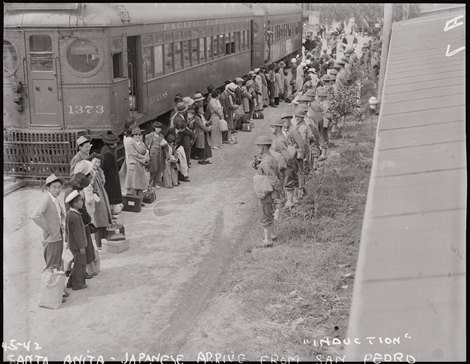Quite by coincidence, the 44th running of the Japan Cup (G1) set for Nov. 24 comes up just a few days after this reporter ventured into the Big City for a tour of the Japanese American National Museum, located on the corner of First Street and Alameda, hard by downtown Los Angeles. I tried not to conflate the events with undue significance, but failed. There clearly was something in the air.
This year’s renewal of the 2,400-meter (about 1 1/2-mile) Japan Cup at massive Tokyo Racecourse offers the first time in a long time a rooting interest for United States fans. Not that there is a North American horse in the field—that has not happened since the grade 1 winner Up With the Birds flew the Canadian flag there in 2014—but top contenders Auguste Rodin and Goliath brim with résumés that link them to these shores.
Coolmore’s Auguste Rodin is a son of 2006 Japan Cup winner Deep Impact, who in turn was a son of Sunday Silence, the U.S. Horse of the Year in 1989, whose combination of Kentucky and California DNA revolutionized Japan’s bloodstock universe. Auguste Rodin also had the good taste to win North America’s richest grass race by capturing the 2023 Breeders’ Cup Turf (G1T) at Santa Anita Park under a rail-skimming Ryan Moore ride.
Goliath is a 4-year-old German gelding who dismantled a stellar field in the King George VI and Queen Elizabeth Stakes (G1) in July, a performance so striking that Kentucky’s John Stewart of Resolute Farm had to have him. So he got him, most of him anyway, and as a result, Goliath could give an American owner a Japan Cup victory for the first time since 1991, when Golden Pheasant came through for the National Hockey League’s L.A. Kings owner Bruce McNall and his favorite hockey player, Wayne Gretzky.

Golden Pheasant wins the 1991 Japan Cup at Tokyo Racecourse
There is no reference to the Thoroughbred racing relationship of Japan and the United States at the Japanese American National Museum. At least, not as such. Even so, the deeply entwined racing history of the two nations presents a story of ebb and flow going back more than half a century to the early 1970s, when an emerging Japanese racing economy began reaching into American bloodstock for invigoration.
California was a particular target. Shigeo Yoshida bought champion mare Typecast for a then-record $725,000 out of the Westerly Farm dispersal and took her home to breed a Japanese champion. His cousin, Zenya Yoshida, became a major player in U.S. racing with such stakes winners as Izanami, Miss Tokyo, and Ski Goggle, trained by California-based Tommy Doyle, as well as partial ownership of Wajima, champion 3-year-old colt of 1975, and in 1991 the full purchase and importation of Sunday Silence.
Horses with U.S. connections won the first two runnings of the Japan Cup in 1981 and 1982, then another in 1988 before Golden Pheasant. Since then, American stables can claim only a handful of placings, while hometown Japanese runners have come to dominate even their European rivals.
Flash forward to recent years, when the welcome mat has been rolled out for Japanese runners competing in U.S. events. Their presence has given domestic racing international cachet, and they have responded with two Breeders’ Cup victories and a near miss in the Kentucky Derby (G1). At Del Mar earlier this month, Japanese horses finished second and third in the Breeders’ Cup Turf (G1T) to repeat winner Rebel’s Romance .
As I wandered through the exhibition halls of the Japanese American National Museum, I could not help but wonder at the arc of history that brought waves of immigrants from Japan to America, first as laborers, then settlers, then business owners and civic leaders with multigenerational roots in a country that betrayed them so comprehensively during the racial panic following the attack on Pearl Harbor by Japanese imperial forces Dec. 7, 1941.
At the time, there were more than 100,000 people of Japanese birth or Americans of Japanese descent living on the West Coast. On Feb. 19, 1942, President Franklin D. Roosevelt issued Executive Order 9066 authorizing the evacuation and internment of 110,000 Japanese Americans, two-thirds of them citizens by birth.
What’s this got to do with horse racing? Well, nothing, really, unless the visitor pauses in the Contested Histories exhibition of the Japanese American National Museum—replete with artifacts from the 75 internment camps and detention centers established from Washington State to Arkansas to keep Japanese Americans behind barbed wire—and watches the video recollections of Jeanne Aiko Miyagishima. She was 7, living in the Bay Area on that Sunday morning in December of 1941:
“We had the radio on, and my dad was just so upset when he heard about Pearl Harbor,” Miyagishima says. “He had become so Americanized, he didn’t even want us to go and learn Japanese. He said, ‘You’re Americans. You learn everything in English.’
“We were all sent to Stockon assembly center, which was a racetrack,” Miyagishima continues. “They whitewashed the stalls, and had some people living there. My sister, Gladys, said there was a lady who’d just had a baby. They had assigned her to one of those places, and you can’t clean a horse stall, make it livable. My mother asked her if she wanted to trade places, because we had a place in the barracks. That’s how much discretion they used when they assigned people.”
Later, I stood in the alcove containing the Ireicho, a book containing the names and birthdates of more than 125,000 first- and second-generation Americans of Japanese descent removed from their homes to prison camps during the war with Japan. I was there to stamp an ink dot by the names of the Hosaka family of San Diego, whose oldest daughter Ayako was my mother’s childhood friend. As my mother told it, “One day Ayako was in school, then the next day she was gone.”
Arrayed on the walls surrounding the Ireicho were vertical planks topped by glass jars containing a variety of soil samples. On each plank were written the names of the places people were imprisoned, among them Santa Anita, Stockton, and Tanforan, all active California racetracks commandeered for wartime use. The soil was taken from each of the many sites.
The round-up of Japanese Americans is one of those dark spots hard to erase, no matter what degree of national security was considered at stake. In the end, it appeared as if the forces that promoted the draconian Immigration Act of 1924, virtually eliminating legal immigration from Japan, had discovered in war panic another way to exercise their racial animus. It was recommended by one government official that anyone with even one-sixteenth Japanese blood be removed to a camp.
However, the mass relocation and imprisonment of Japanese Americans flew in the face of a raft of reports from respected officials that found no sound basis for allegations of a security risk. Among them was, Lt. Cmdr. Kenneth Ringle of the Office of Naval Intelligence, who had been studying the possible threat of the “Issei” population since mid-1940 and concluded:
“That, in short, the entire ‘Japanese Problem’ has been magnified out of its true proportion, largely because of the physical characteristics of the people; that it is no more serious than the problems of the German, Italian, and Communistic portions of the United States population, and finally that it should be handled on the basis of the individual, regardless of citizenship, and not on a racial basis.”

Persons of Japanese ancestry arrive at the Santa Anita Assembly Center in 1942
We did it anyway. The Hosaka family was taken by train from San Diego to Santa Anita and lived in stalls until they were transferred first to the Poston camp on seized Native American land in Arizona, then on to the Crystal City camp in Texas. The Miyagishima family went from Stockton to the Gila River camp, also in Arizona, and remained there until the camps began closing in late 1944. More than 1,800 of the imprisoned died in the camps. There were no documented cases of wartime espionage traced to Japanese Americans.
Of all the great racing events this pilgrim has attended—which includes the Melbourne Cup (G1), the French Derby (G1), two Dubai World Cups (G1), a bunch of Kentucky Derbies (G1), and the Doncaster St. Leger (G1) with an English Triple Crown on the line—there is nothing that compares to the pomp and ceremony of a Japan Cup.
The horses are viewed reverently in the vast walking ring by thousands, then played into the starting gate by a big brass band, while the official starter ascends to his position via hydraulic lift to the cheers of more than 100,000 fans waving white cloths, chanting in delirious unison. The winner is celebrated by blankets, garlands and imperial recognition. The winning trainer, owner, jockey, and groom are accorded their private platforms, elevating them above their vanquished opponents. Then more music.
Frank Angst, BloodHorse editorial director, is on the scene this week to provide eyewitness accounts for all things Japan Cup and Japanese racing. Lucky him. Nothing sounds like more fun, but an afternoon spent at the Japanese American National Museum in Los Angeles—Little Tokyo to be precise—turned out to be every bit as rewarding.








